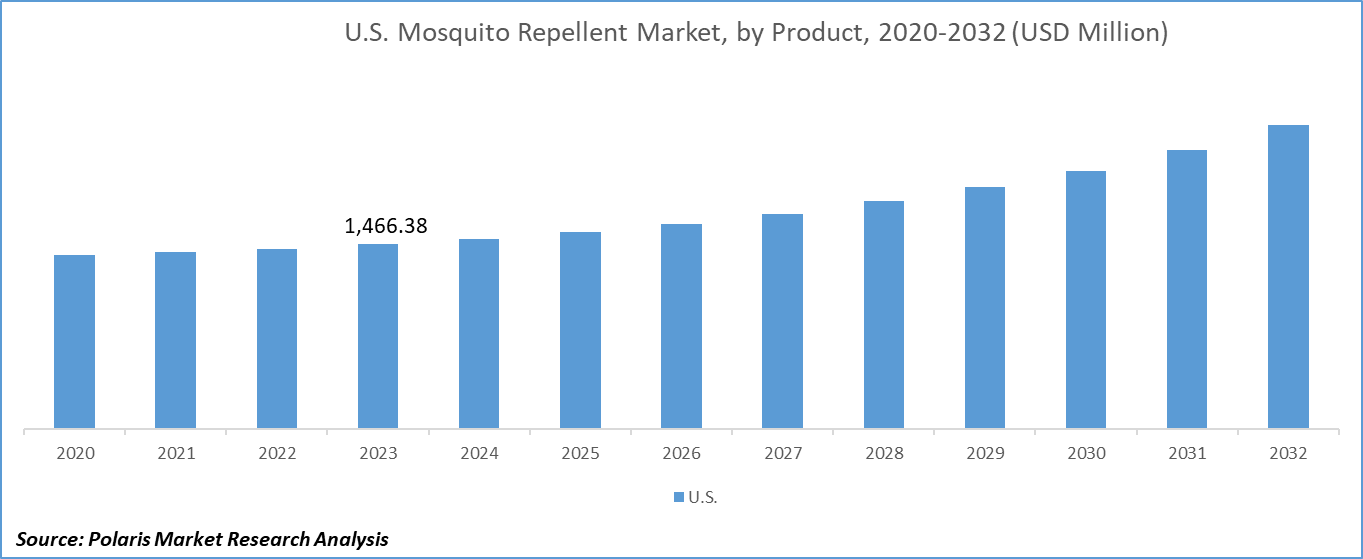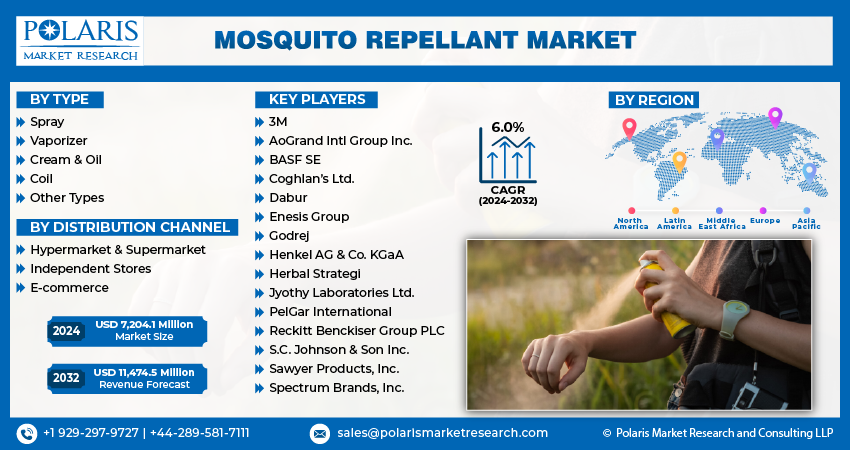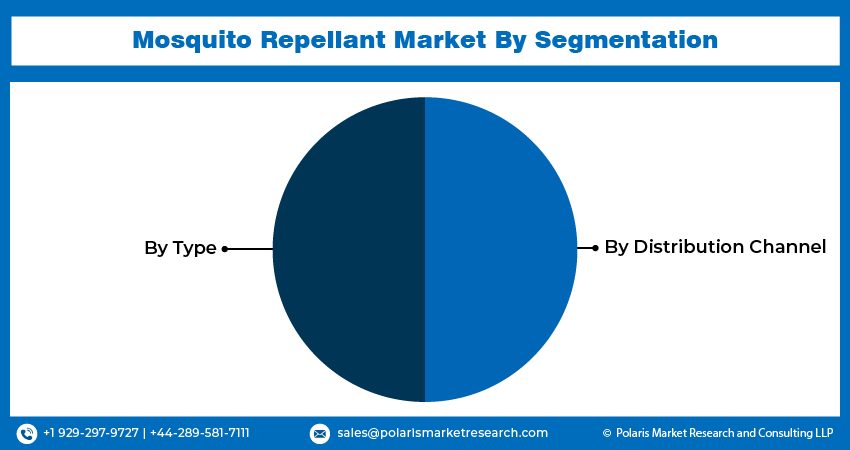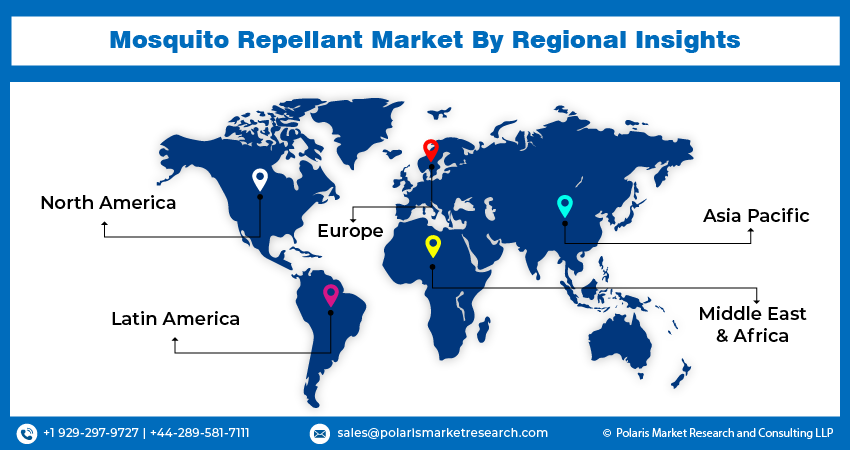
Mosquito Repellent Market Share, Size, Trends, Industry Analysis Report, By Type (Spray, Vaporizer, Cream & Oil, Coil, Other Types); By Distribution Channel; By Region; Segment Forecast, 2024 - 2032
- Published Date:Apr-2024
- Pages: 112
- Format: PDF
- Report ID: PM2411
- Base Year: 2023
- Historical Data: 2019-2022
Report Outlook
Mosquito Repellent Market size was valued at USD 6,992.9 million in 2023. The market is anticipated to grow from USD 7,204.1 million in 2024 to USD 11,474.5 million by 2032, exhibiting the CAGR of 6.0% during the forecast period
Industry Trends
The growing incidence of infectious diseases such as dengue, Zika, and yellow fever that are caused by the mosquito, increasing housing waste, as well as improper waste management are the primary factors that are augmenting the industry demand.
This is a material that is designed to prevent mosquitoes from biting humans and feeding on their blood. In addition, changing environmental conditions like heavy rainfall, unstable temperature, etc., are also leading to the chances of breeding, which further acts as catalyzing factor for the industry expansion across the globe. Moreover, increasing investment in R&D activities and adoption of herbal products or chemical-free products in the mosquito repellent market is also creating product demand over the forecasting years.

To Understand More About this Research:Request a Free Sample Report
The widespread of COVID-19 has shown a huge impact on the various sector of the economy. The mosquito repellent market also exhibits a positive influence. As per the Department of Homeland Security, In the United States, pest control services remained active during this period because it was categorized as an ‘essential service’.
Various vacant premises without pest control and undisturbed conditions were leading to a higher demand for mosquito breeding, cockroach infestation, and rodent activities. Moreover, growing health awareness and increasing spending on healthcare products are offering various growth prospects for the industry growth during this period. The growing incidence of mosquito-borne diseases is one of the chief driving factors for the industry growth. As per the World Health Organization (WHO), mosquito bites witness more than one million people to die each year. Most of the deaths among them are caused by malaria. Also, WHO projected that every year between 300 and 500 million cases of malaria occurs. In addition, the prevalence of dengue also increases and affects nearly 400 million people in a year, and some of them need to be cured under doctors' observation.
Key Takeaways
- Asia Pacific dominated the market and contributed over 36% market share of the mosquito repellent market size in 2023
- By type category, the cream & oil segment dominated the global mosquito repellent market size in 2023
- By type category, the e-commerce segment is projected to grow with a significant CAGR over the mosquito repellent market forecast period
What are the market drivers driving the demand for market?
Increasing Awareness about Mosquito-Borne Diseases
In recent years, there has been a significant surge in awareness about mosquito-borne diseases, driven by growing public health concerns, increasing incidence rates, and heightened media coverage. This heightened awareness has emerged as a crucial driver for the mosquito repellent market globally. Mosquito-borne diseases pose substantial health risks to populations worldwide, and the rising consciousness about these illnesses has propelled the demand for effective mosquito repellents and control measures. The increasing prevalence of mosquito-borne diseases, such as malaria, dengue fever, Zika virus, chikungunya, and West Nile virus, has raised public health concerns globally. These diseases cause severe illness, long-term health complications, and even death in some cases. As a result, individuals and communities are increasingly seeking preventive measures to protect themselves from mosquito bites, thus driving the demand for mosquito repellents.
Media channels, including television, radio, social media, and online platforms, play a significant role in disseminating information about mosquito-borne diseases. News reports, health advisories, and educational campaigns raise awareness about the risks associated with mosquito bites and emphasize the importance of using effective repellents. As a result, consumers are more informed about the need for mosquito protection products, driving market growth.
Governments and public health organizations worldwide are implementing initiatives and campaigns to combat mosquito-borne diseases. These efforts often include distribution programs for mosquito nets, repellents, and educational materials to vulnerable populations. By promoting awareness and preventive measures, governments contribute to the increased adoption of mosquito repellents, thereby stimulating market demand. With globalization and increased travel activity, individuals are more exposed to mosquito-borne diseases in regions where they may not have previously been prevalent. Travelers seek protection against mosquito bites to prevent contracting diseases while visiting areas with endemic mosquito populations. This heightened awareness of travel-related risks drives the demand for portable and effective mosquito repellents among travelers.

Which factor is restraining the demand for the market?
Emergence of resistant mosquito strains and competition from alternative solutions hinder the mosquito repellent market growth
Continuous exposure to chemical insecticides and repellents contribute to the development of resistance in mosquito populations, rendering certain products less effective over time. Mosquito species such as Aedes aegypti and Anopheles gambiae, which transmit diseases like dengue fever and malaria, have demonstrated resilience to conventional control methods, posing challenges for mosquito management programs and necessitating the development of alternative strategies.
The mosquito repellent market faces competition from alternative mosquito control methods and products, including mosquito nets, traps, citronella candles, electronic repellent devices, and natural remedies. Consumers explore diverse options based on factors such as effectiveness, convenience, affordability, and personal preferences, thereby diluting market share for traditional repellent products and intensifying competition among industry players.
Report Segmentation
The market is primarily segmented based on type, distribution channel, and region.
|
By Type |
By Distribution Channel |
By Region |
|
|
|
To Understand the Scope of this Report:Speak to Analyst
Category Wise Insights
By Type Insights
Based on type category analysis, the market has been segmented on the basis of spray, vaporizer, cream & oil, coil, and other types. In 2023, the cream & oil segment has emerged as the dominant segment in the global market because consumers are increasingly seeking convenient and user-friendly mosquito repellent solutions that offer long-lasting protection against mosquito bites. Creams and oils provide a hassle-free application method, allowing individuals to easily apply the repellent to exposed areas of skin, thereby creating a protective barrier against mosquitoes.
Also, the formulation of creams and oils often includes natural ingredients such as essential oils like citronella, eucalyptus, or lavender, which are perceived as safer alternatives to synthetic chemicals by health-conscious consumers. The growing awareness about mosquito-borne diseases such as malaria, dengue, and Zika virus is driving demand for effective repellents, with creams and oils being perceived as reliable options for personal protection, especially in regions where mosquito-borne diseases are prevalent. The convenience, efficacy, and perceived safety of cream and oil-based mosquito repellents have thus propelled this segment to dominance in the global market.
By Distribution Channel Insights
Based on distribution channel category analysis, the market has been segmented on the basis of hypermarket & supermarket, independent stores, and e-commerce. The e-commerce segment is projected to witness a progressive growth rate in the forecasting years. The adoption of e-commerce trading has changed the way business is global. It is a huge platform that is rapidly growing at an ever-increasing rate.
Also, various online supplier of mosquito repellent sells their products via a digital website that facilitates consumers to find specific brands, models, or items, which boost the sales of mosquito repellent worldwide. Consequentially, increasing demand for smartphones and the rising proliferation of the internet is further fuelling the segment demand in the approaching period.

Regional Insights
Asia Pacific
Asia Pacific accounted for the largest revenue share in the global market. The imposition of stringent regulatory policy for population health & hygiene and increasing healthcare spending is creating a lucrative demand for the mosquito repellent market. In addition, enhanced living standards, increasing population, and reasonable pricing of repellents have also propelled the market penetration in household goods. The surging adoption of insect repellents in usable varieties like powders, chalks, sprays, vaporizers, and others in both commercial and residential sectors are further creating productive demand for market growth across the Asia Pacific region.
Europe
The European market is anticipated to exhibit the highest CAGR over the forecasting years. The presence of a huge consumer base, growing awareness about the availability of mosquito repellent, as well as the rising disposable income is contributing to the market growth. Additionally, increasing incidences of mosquito-based diseases, like a virus, zika, malaria, dengue, West Nile Virus (WNV), and chikungunya, along with the growing presence of leading repellent manufacturers are also offering various growth prospects in the near future.

Competitive Landscape
The market features a competitive landscape characterized by the presence of several key players striving to gain a competitive edge through product innovation, strategic partnerships, and extensive distribution networks. Established companies such as Godrej, Reckitt Benckiser Group plc, and Spectrum Brands, Inc. dominate the market with their wide range of mosquito repellent products, including sprays, creams, oils, and electronic devices. These players focus on continuous research and development to introduce advanced formulations with improved efficacy and longer protection durations, catering to evolving consumer preferences.
Some of the major players operating in the global market include:
- 3M
- AoGrand Intl Group Inc.
- BASF SE
- Coghlan’s Ltd.
- Dabur
- Enesis Group
- Godrej
- Henkel AG & Co. KGaA
- Herbal Strategi
- Jyothy Laboratories Ltd.
- PelGar International
- Reckitt Benckiser Group PLC
- S.C. Johnson & Son Inc.
- Sawyer Products, Inc.
- Spectrum Brands, Inc.
Recent Developments
- In August 2023, The Swiss Tropical and Public Health Institute (Swiss TPH) collaborated with BASF and Promega to explore and create insect control tools that can effectively tackle mosquito-borne diseases, including malaria.
- In August 2023, Godrej Consumer Products Limited (GCPL) has entered into a Memorandum of Understanding (MoU) with the State Government of Tamil Nadu. Under this agreement, GCPL will set up a cutting-edge manufacturing facility in the state, committing an investment of INR 515 crore over the next five years.
- In April 2023, SC Johnson and the government of Kenya formed a new public-private partnership to combat the spread of malaria by developing and distributing low-cost, long-lasting spatial repellent products.
- In June 2022, SC Johnson introduced a new range of bug-killer sprays and mosquito repellents called STEM. This new lineup is formulated using scientifically precise combinations of botanical extracts to enhance effectiveness.
Report Coverage
The mosquito repellent market report emphasizes on key regions across the globe to provide better understanding of the product to the users. Also, the report provides market insights into recent developments, trends and analyzes the technologies that are gaining traction around the globe. Furthermore, the report covers in-depth qualitative analysis pertaining to various paradigm shifts associated with the transformation of these solutions.
The report provides detailed analysis of the market while focusing on various key aspects such as competitive analysis, type, distribution channel, and their futuristic growth opportunities.
Mosquito Repellent Market Report Scope
|
Report Attributes |
Details |
|
Market size value in 2024 |
USD 7,204.1 million |
|
Revenue forecast in 2032 |
USD 11,474.5 million |
|
CAGR |
6.0% from 2024 – 2032 |
|
Base year |
2023 |
|
Historical data |
2020 – 2022 |
|
Forecast period |
2024 – 2032 |
|
Quantitative units |
Revenue in USD million and CAGR from 2024 to 2032 |
|
Segments covered |
By Type, By Distribution Channel, By Region |
|
Regional scope |
North America, Europe, Asia Pacific, Latin America; Middle East & Africa |
|
Customization |
Report customization as per your requirements with respect to countries, region and segmentation. |
FAQ's
The global mosquito repellent market size is expected to reach USD 11,474.5 Million by 2032, according to a new study by Polaris Market Research.
Key players in the market are 3M, AoGrand Intl Group Inc., BASF SE, Coghlan’s Ltd., Dabur, Enesis Group, Godrej, Henkel AG & Co. KGaA
Europe contribute notably towards the global Mosquito Repellent Market
Mosquito Repellent Market exhibiting the CAGR of 6.0% during the forecast period
The Mosquito Repellent Market report covering key segments are type, distribution channel, and region.

